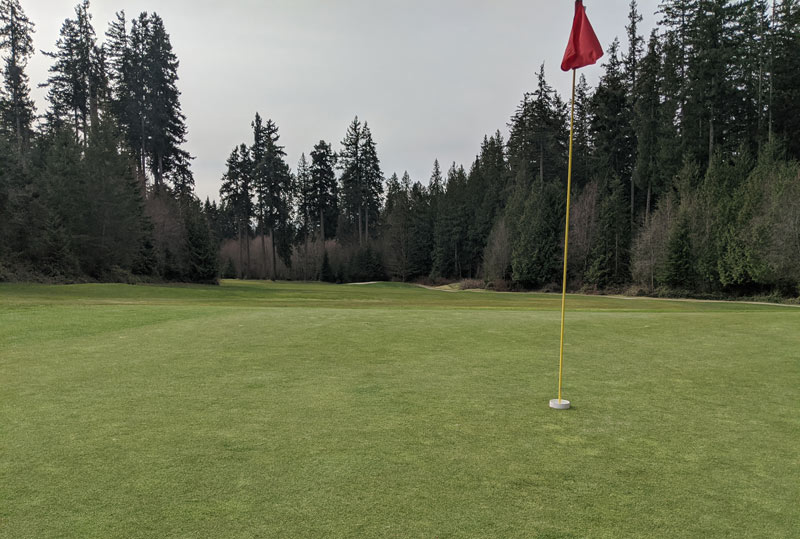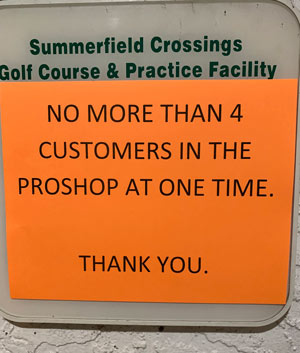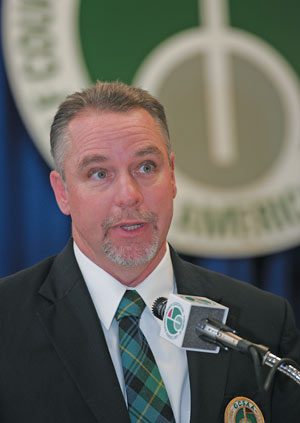
At Sunshine Coast Golf & Country Club in British Columbia, superintendent Jason Haines and crew left cups an inch or two out of the ground earlier this week to allow golfers to “putt out” without needing to touch the flagstick or reach into the hole to retrieve their balls. Photo by Jason Haines
Editor’s note: While there is no lack of general information about the coronavirus available, GCSAA has compiled resources specific to golf and golf course management. Find customizable business and communications templates, relevant OSHA and CDC information, and more on GCSAA’s coronavirus resources page.
On Thursday, March 12 — the day the COVID-19 pandemic lost any remaining abstraction across North America, when the NCAA pulled the plug on March Madness and the NBA marked the first full day of its postseason and all the other sporting dominos tumbled or at least teetered — Hunter Brewer fired off a tweet.
His tweet wasn’t the first, surely, and unquestionably not the last on the topic, but it had to be among the most starkly eloquent — concisely putting words to a question that had to be on the minds of everyone in the golf course maintenance industry.
So what happens, Brewer tweeted, when a Superintendent or Assistant or crew member comes down with this thing? Are we just going to abandon the golf course for 2+ weeks while everyone quarantines? Everyone is in close contact with everyone else on a daily basis. This could be a wild ride.
The tweet didn’t exactly explode, but it did spark a digital discussion that’s far from over.
“For me, up to the point I sent the tweet out, nobody had asked the question, ‘What if one of us gets it?’” says Brewer (@TurfBrewer), senior assistant superintendent at FarmLinks Golf Club at Pursell Farms in Sylacauga, Ala., and an eight-year GCSAA member. “At the time, we were one of four states not to have coronavirus, but it would be crazy to think we didn’t have it here.”
The day after Brewer’s tweet, Alabama confirmed its first case.
“I was just thinking, how can we get ahead of this thing?” Brewer says. “And I know other guys were thinking the same thing. The response was great — generated a lot of great ideas.”
Less than a week later, it has become obvious there is no easy answer. Heck, it may not even be the right question.
But what is?
“I’d say it’s a huge international effort to figure it out,” says Jason Haines, superintendent at Sunshine Coast Golf & Country Club in Roberts Creek, British Columbia, and a four-year GCSAA member. “But I think everybody is just waiting for leadership from the government. What do we do? What are we allowed to do? Who am I to say golf is safe? I’m not an epidemiologist; I’m just a greenskeeper. All we can do is reduce potential risk areas. But, again, I’m not an infectious disease expert. What do our staff do? How can we pay our bills if we can’t work? How can the golf course pay our bills if it’s not open?”
Adjusting course
Recently, Haines and his staff have made several changes to the way they work and prepare the 18-hole golf course.
“We’ve been, obviously, disinfecting common areas, common surfaces,” Haines says. “And we’re reducing common surfaces — (removing) bunker rakes, ball washers. They’re saying the virus can survive outside the body two to three days on certain surfaces. Obviously, we’re disinfecting the driving range and washing carts.”
One novel tactic: raised cups. The Sunshine Coast G&CC staff is leaving an inch or two of each cup above the putting surface, eliminating the need to remove the flagstick — which, under the Rules of Golf, is unnecessary now anyway — or to touch the inside of the cup.
“If you hit the cup with your ball and it doesn’t bounce more than a putter’s length away, you call it a sunk putt,” Haines says.
Brewer’s course is instructing golfers to leave the flagsticks in.
“We’ll have our starter encouraging people to take gimmes,” he says. “You know, ‘Pick that 3-footer up. Give each other gimmes.’
“We’re a huge, open-air space,” Brewer adds. “You should feel safe here. You should be safe here.”
A fluid situation
It’s all very much a moving target.
Consider the case of Michigan on Monday. Gov. Gretchen Whitmer issued an executive order announcing “temporary restrictions on the use of places of public accommodation” and specifically mentioned golf clubs and country clubs as among the places that, as of 3 p.m. Monday, were to close until March 30.
After what the Detroit News described as a frantic, confusing day for many staff members of the state’s 650 courses — the paper reported some courses kicked golfers off the property and closed; others remained open — a spokesperson for Gov. Whitmer clarified Monday night that the closings were meant only for the courses’ pro shops and clubhouses. The actual playing of golf could continue — subject to all other (and, often, changing) restrictions.
Similarly, in Washington — the state hardest hit so far by the coronavirus, specifically the Seattle area — Gov. Jay Inslee on Monday announced, effective at midnight, that all “restaurants, bars, and entertainment and recreational facilities” were to close temporarily, but the fate of the state’s golf courses was ... murky. The situation had cleared somewhat by Monday night, when it appeared golf courses could remain open — with restrictions, such as limits to the number of people per gathering — but food service, for instance, would have to close or meet other restrictions, such as no dining in.
What about the agronomy?
Back to Brewer’s tweet: Are we just going to abandon golf courses for two-plus weeks?
“It’s 80 degrees here today,” Brewer said Monday. “We’re about to be on a mowing schedule pretty quick. I don’t know if we can survive if we lose a whole crew for two weeks or longer. Now it sounds like this might be the new normal through July or August. Right now, there are a lot more questions than answers.
“I guess a worst case, if nobody could be here two weeks ... I live on the property. If it came to that, I’m here. I could do greens by myself — if I’m not sick. I could at least keep everything alive. Any longer than that, you might talk about losing greens. People say, ‘It’s just grass,’ but you can’t grow a green overnight. That’s a scary point for me. We’re a bentgrass course in Alabama. The window is pretty tight for the stress this thing can handle. I’m not worried about losing greens this time of year, but ... ”

FarmLinks Golf Club at Pursell Farms, an 18-hole facility in Sylacauga, Ala., where Hunter Brewer is the senior assistant superintendent. Photo courtesy of FarmLinks Golf Club
In that regard, Haines is fortunate.
“We’re lucky,” he says. “Normally, we’d probably be applying our first fertilizer of the season.
We’re stopping all of that. Growth rates are super slow right now. We are charging our irrigation system. If we need to, we can remotely operate the sprinkler. We don’t need that much water anyway. We are stocking up on irrigation parts, so if we do have any breaks, we can fix them. And we’re figuring out how few people we need. I figure I could do it with one person. We could go six weeks with zero maintenance. It wouldn’t be the end of the world, but it would take a while to get it back.”
That’s right now. In a month or so, growing season will begin in earnest.
“The grass just starts to jump out of the ground,” Haines says. “We could have a three-person skeleton crew, and 100% of what we’d do would be just mowing. Of course, if the golf course isn’t open, there are a lot of things you don’t have to do — you don’t have to worry about rolling greens, mowing greens, and you could let your fairways go dormant.”
‘I don’t have guys working together’
Some golf courses remain open, and even those closed to the public can, in some cases, still be staffed.
But just how do golf course superintendents manage their employees in the days of social distancing?
Summerfield Crossings Golf Club in Riverview, Fla., was still open as of the writing of this article — just hours after Florida Gov. Ron DeSantis announced the closure of all bars and nightclubs for 30 days, prompting yet another meeting of Summerfield Crossings’ management about the potential implications for golf.
“Most of my guys have been keeping their distance from one another, and most bring their own lunch and sit in different areas of the shop or somewhere out of the way on the golf course,” says Keith Lamb, GCSAA Class A superintendent at Summerfield Crossings and a 17-year GCSAA member.

Right: At Summerfield Crossings Golf Club in Riverview, Fla., superintendent Keith Lamb and his crew are spending extra time cleaning and disinfecting touch points — flagsticks, carts, etc. — or removing them entirely. Signage also makes plain the limitations to group size and food and beverage availability. Photo by Keith Lamb
Courses across the country have reported altering their shift schedules to avoid overlap. For Lamb, that isn’t an issue.
“I don’t have a large crew, and my guys stagger their arrival as it is,” he says. “All of our tasks right now are individualized, so I don’t have guys working together. Only exception is, I have two guys who are brothers and live in the same household, so they have been assigned tasks to complete together. We have no plans to cut our staff unless ordered by the government or my owner. I could keep things going with just three to four guys, but my staff is only eight guys to begin with.”
The bottom line
Golf, like nearly all industries, walks a fine line. Courses need to remain open, but they’re obligated to keep their staffs and patrons safe. They might need to close to ensure the latter, but then how long can they stay closed and hope to reopen?
“One concern I have is if we were forced to shut down and quarantine for any length of time,” Lamb says. “I’m not sure how long ownership could afford to pay us, and I haven’t heard any real financial relief coming from the government. The one-time $1,000 payment would be a joke if we were out more than two weeks.”
That’s only part of the worry. While some courses are reporting an increase in rounds played — those who can’t go to work or gather in groups often seek outside solo or small-group recreation — for others, business is understandably slow. And as paychecks get missed and jobs lost, golf will likely take another hit.
“We’re a semiprivate club,” Haines says. “Our membership dues carry us into mid-spring. We rely on green fees after that to stay open. If everybody else is self-quarantined, they won’t have any discretionary money to golf. I don’t see how we’ll be able to stay open.”
Shortly after speaking with GCM on Tuesday, Haines learned Sunshine Coast Golf & Country Club would be closing indefinitely.
‘Perspective is important’
About a 12-hour drive to the southeast of Haines’ course sits Seneca, Ore., home of the Retreat & Links at Silvies Valley Ranch, a remote, eco-friendly resort that features 52 holes over four courses. Sean Hoolehan, CGCS, who served as GCSAA president in 2006, is the superintendent there. The courses are slated to open May 1, so coronavirus responses have been minimal.

“So far, nothing,” says Hoolehan (right), a 35-year association member. “We have temporarily closed all the food and beverage operations. We are in wait-and-see mode right now, preparing the course and grounds for visitors but keeping an eye on the COVID-19 situation, following all state guidelines.”
Guidelines for the way people play golf are more fluid, Hoolehan says. “It is going to take communication and golfer cooperation. It’s not going to be golf by USGA rules necessarily, but it beats the alternative,” he says.
In response to Brewer’s tweet, Hoolehan shared words of wisdom.
It’s a golf course not a hospital. Everything will be salvageable. It might be a good idea to take measures to keep your staff and patrons safe. Perspective is important right now. #FlattenTheCurve
Speaking with GCM, he offered further perspective: “Superintendents are leaders first, managers second and agronomists third,” Hoolehan says. “Now is a time to lead. First, don’t let anxiety paralyze you. Focus on your family, staff and facility, in that order. I have a saying: We aren’t saving lives at work. There is no job on the course worth risking your, your staff’s and, in this case, your staff’s families’ health and well-being. Always remember there are people in worse shape than you.
“I have been a superintendent through Black Monday in 1987; Sept. 11, 2001; the Great Recession of 2008; and now this. All seemed dire on a national scale. My parents grew up in the Great Depression and were thrown right into World War II. Adversity is part of life. Embrace, learn and move on.”
Andrew Hartsock is GCM’s managing editor.